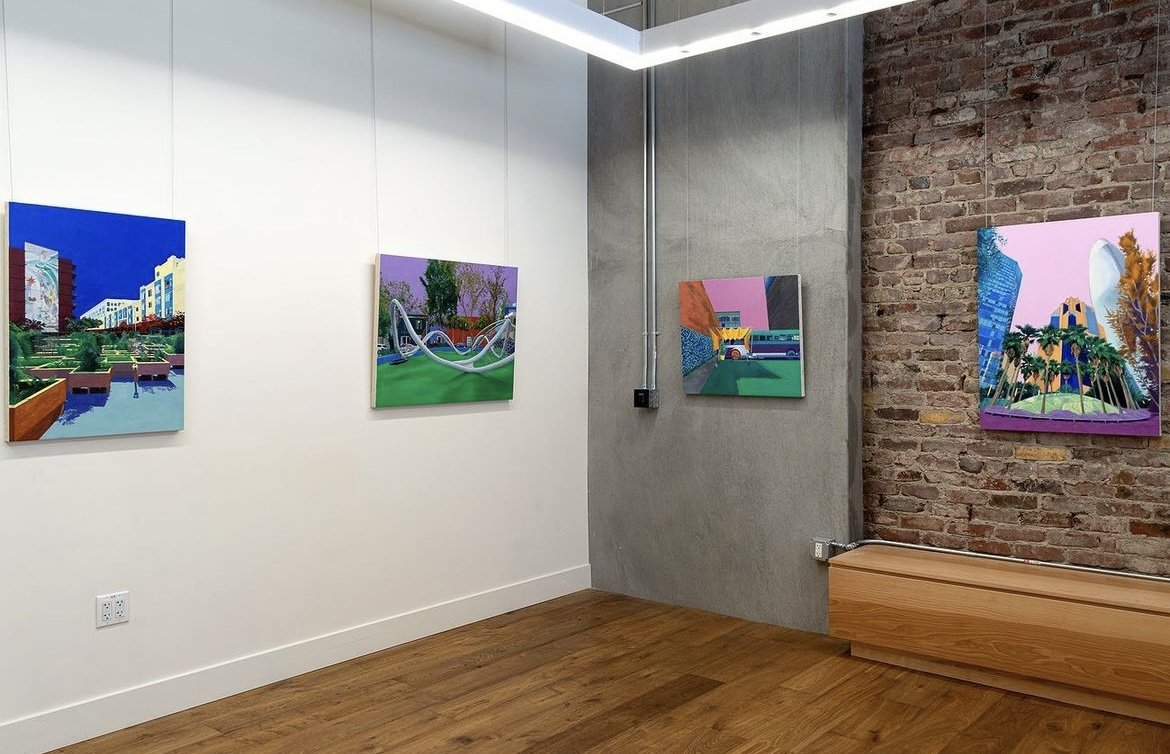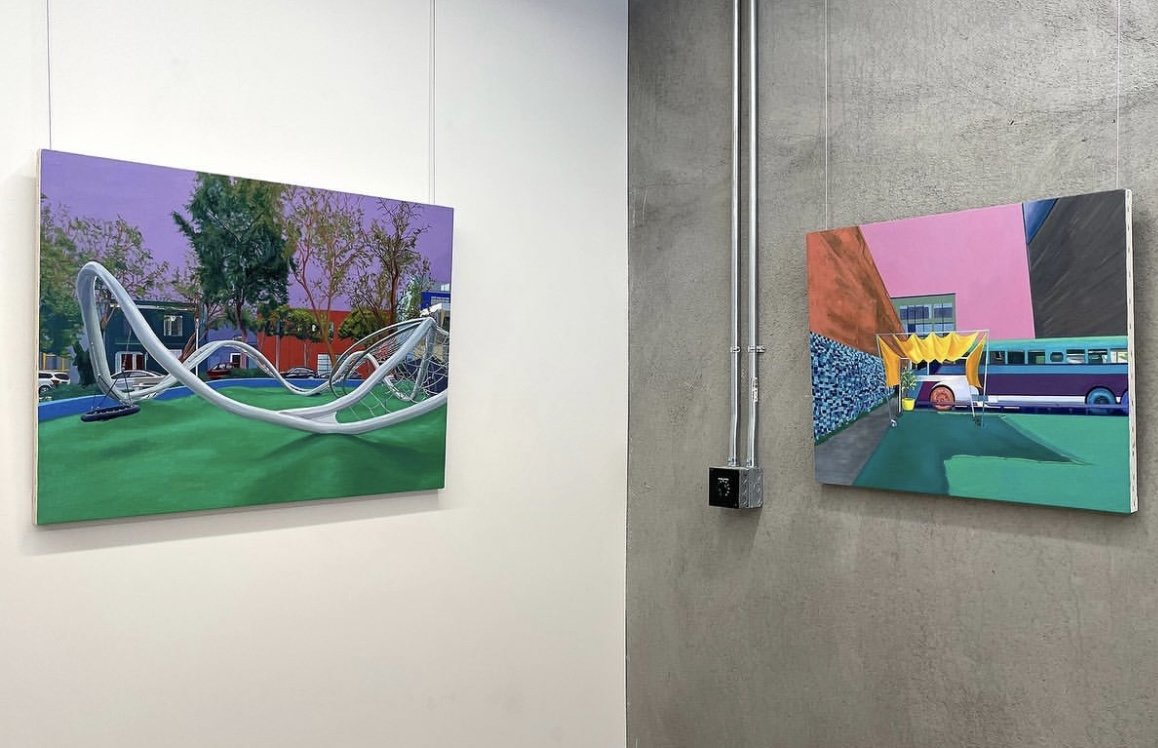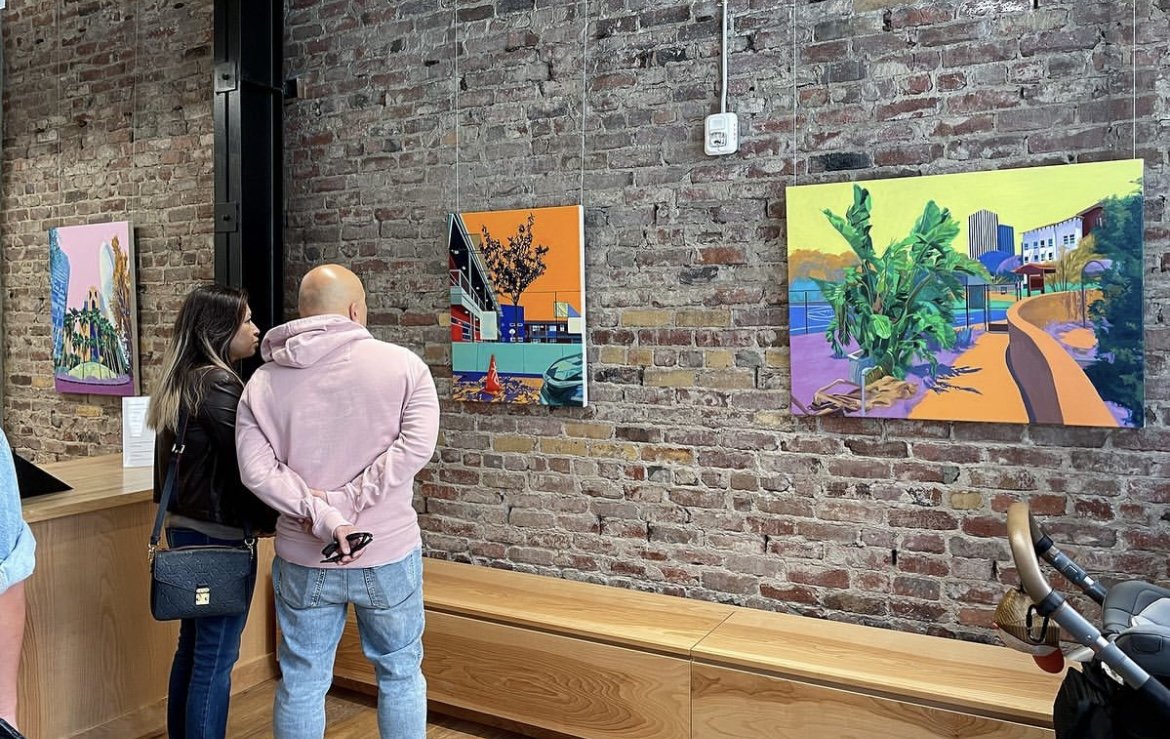Exploring SOMA Pilipinas Through Oil Paint & Introspection with Cherisse Alcantara
To the average pedestrian strolling down the SOMA Pilipinas Cultural District in San Francisco, the calamansi planters at Kapwa Gardens or the banana tree at the Victoria Manalo Draves Park may seem insignificant.
But what if that pedestrian were to stop? And gaze? And think? And paint? And continue to think while painting?
Painter and Balay Kreative Growth Grantee Cherisse Alcantara explores this question and many more. For Cherisse, these details add depth to a scene. Suddenly, to explore SOMA Pilipinas doesn’t merely entail a walk in the park. Rather, it’s a mindful practice and rich discourse of how public spaces can serve communities.
In an interview with Kurt Ison, Cherisse discusses her artistic development and art education, how oil paints illuminate her urban subjects, and how she invites viewers to think about her work.
Profile by Anne Lizette Sta. Maria
“I’m very interested in how we can find belonging in these places, how we can find beauty but also comfort, how they can be welcoming places, how accessible they are, and the offerings that they have for the community or the public that they serve.”
As a child, did you always know you wanted to be a painter?
For me, the journey was not a straight path. When I migrated to the United States, to Northern California in my early teens, adapting to a new culture and country and language was initially difficult and challenging for me. So I took comfort and solace in my high school art classes, and that’s when I started taking art more seriously. I did not pursue it right away after high school. I tried something more practical and more acceptable as a path, but eventually I came to the realization that art was my path. I’ve been painting since then.
Cherisse, posing in front of some of her art pieces
What media do you use to paint? How do they produce your desired effect?
I am primarily an oil painter, so I paint with oil paintings on canvas or linen. I tend to be particular with how I prepare or prime my ground. Although I don’t like to fetishize materials and methods, I do it in a manner that is traditional — in a way that a 17th or 18th century painter would. I do it because it’s suitable for my work. I think it really brings out the colors. I also really love the sensuousness of oil paint. I love all the textures and surfaces and luminosity that you can achieve through oil paint. Lastly, [I love that] paint pigments have unique colors to them; they’re really hard to produce digitally.
How has your formal art education helped you in your career?
I believe that the best education for artists is self education. Artists are always continuously learning and teaching themselves, whether it’s through school or independent study. Having said that, I did pursue my undergraduate and graduate art degrees, first at UC Berkeley and then at the Pennsylvania Academy of the Fine Arts. There’s a couple reasons [as to why]. First, I did not grow up with role models nor did I grow up in an artistic family or community, so it was a way for me to access the arts and be in a supportive environment — in other words, a way for me to find my people. The second reason is that I tend to be intuitive with the kind of learning that I need at a particular period in time for my artistic development. For instance, I decided to go to grad school because I felt like I wanted to be challenged in thinking more critically about my work, so I really enjoyed all the critiques. You have studio visits and you get very strong and different opinions about your work, and it really forced me to think for myself so that, in the end, I would be able to say that this is what I want to do, this is how I want to do it, and this is why I do it.
Paintings by Cherisse, scenes of Kapwa Gardens and the Victoria Manalo Draves Park
How does the city of San Francisco influence your art?
San Francisco is such a beautiful city, and I feel really lucky to live here. I have lived in the East Bay and Oakland for many years before moving here about a year ago. With an emphatic gaze and hopefully with criticality and humor, I reflect upon the built spaces that I inhabit. It’s also a way for me to stay with places and dwell longer. Although my works are rooted in reality, I like to think of them more as imaginary spaces that hold abstract ideas and thoughts. I really love to observe the changes around me, especially the new developments happening here. There are many things that happen to this city that are unique to this city, but also are reflective of what’s going on in other places.
Can you talk a little bit about your current project?
I’m creating six paintings for this upcoming exhibition, and I’m approaching it as a residency in SOMA. I’m limiting myself to the places and sights here in SOMA. Through parks and public spaces, I reflect upon the history and continued presence here of the Filipinx community here in the SOMA Pilipinas Cultural District.
I’m also observing the changes here in the South of Market neighborhood. For instance, I did a painting of the Victoria Manalo Draves Park, which is named after a Filipina Olympian driver. I also did a painting of the Alice Street Community Gardens, which overlooks Hero’s Village and has these affordable housing complexes for seniors.
I’d like to think that this is the point of departure for these works. I’m continuing my explorations of everyday and ordinary moments, but I am exploring how I encounter nature within the built world. I was very drawn to the banana tree at the Victoria Manalo Draves Park or the calamansi planters at Kapwa Gardens because they reminded me of my cultural background.
For this project, I’m really interested in how we construct or build or design. I’m very interested in how we can find belonging in these places, how we can find beauty but also comfort, how they can be welcoming places, how accessible they are, and the offerings that they have for the community or the public that they serve.
Lastly, I’m interested in change. A lot of my paintings have these moments of change or transience — moments that remind me of the presence of time, like recurring shadows or plants in nature that show growth and decay, or constructions and deconstructions that I see around me.





Cherisse’s exhibition at Undiscovered Creative Market & Festival
What does being a part of Balay Kreative mean to you?
When I returned to the Bay Area a year ago from the East Coast after graduating, I felt out of touch with the arts community here. A lot of people that I used to know have dispersed [also due to] the ongoing effects of the pandemic. Through Balay Kreative, it’s really wonderful to meet creatives and artists here in the Bay Area, especially those that I share a cultural background with. I find it a supportive community that supports multiple voices. I also really enjoyed the mentorship program and the workshops because they gave me practical business tools. Most especially, I see my project as something that will be expanding beyond the grant period. I think [the grant] has provided me with this exciting direction for my art.
What kind of statements are you looking to make with your art?
I would like to offer the viewer the experience of looking, and hopefully, one that turns inward. I never provide answers in my works for the viewer, but I want to invite them to think through with me and hopefully gaze longer and slower. I also think being able to do that is really wonderful for this contemporary world we live in.
“I never provide answers in my works for the viewer, but I want to invite them to think through with me and hopefully gaze longer and slower.”
What would you say to aspiring Filipino artists? Why is it important for Filipinos to create?
I did not grow up with role models in the arts, nor did I grow up in an artistic community nor did I initially have support or encouragement to pursue art, so I think it’s important for the next generation to see artists of color especially Filipinx and AAPI women artists. Having grown up in a post colonial country but also in a post colonial background, there are many things that have remained because of colonialism and the mentality that your voice is not important. So I think it’s important for our voices to be heard. Within this voice are multiple voices and narrative. All of them should be equally important.
Want to know more about Cherisse? Be sure to follow @balaykreative and subscribe to our newsletter to hear about her future artwork! Check out our interview with her below.


